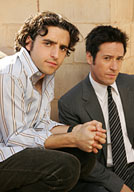Some Dramatis Personae for Unit 3
Paul Appell - (1855-1930), Fr., math., His daughter (see below) was married to Emile Borel; Sorbonne faculty; usually a supporter of M. Curie but did not support her during the scandal period and disapproved of his daughter taking her in.
Niels Bohr - (1885-1962), Dan., phys., In 1913 proposed a model of the atom that involved shells of electron activity. is work laid the groundwork for Quantum Physics. He rec'd the Nobel Prize for Physics in 1922.
Edouard Branley - (1844?-1940?) Branley linked radio waves to electrical current which helped to make radio broadcasting possible.
Emile (1871-1956) and Marguerite (1883?-1969?) Borel - Emile was a French mathematician who worked in a number of areas, including functions, game theory and probability. Marguerite had a successful career as a writer and published fiction under the pseudonym "Camille Marbo". The couple were friends of M. Curie and took her in when scandal broke.
Albert Einstein - (1879-1955), Ger/Amer, phys., Best known for three papers published in 1905. In one he proposed his theory of special relativity that deals with particles moving at high speeds. In a second, he explained photoelectric effect and in a third he explained Brownian motion. He later developed his theory of general relativity ( having to do with gravitational force and the effect of mass on space). His later career was spent trying to create a unified theory that would successfully describe all known natural forces as aspects of one single force. He was awarded the Nobel Prize for Physics in 1921.
Hans Geiger - (182-1945), Ger., phys., Inventor of a device that responds to the presence of alpha particles (1913) - the Geiger counter.
Ernest Marsden - (1889?-1970?), NZ, phys., Worked with Geiger under Rutherford; alpha particle scattering experiment (1908).
Heike Kamerlingh Onnes - (1853-1926), Neth., phys., Worked in a number of areas; worked with M. Curie on radioactive substances at low temperatures; rec'd Nobel Prize for Physics in 1913. (See article on absolute zero and superconductivity.)
Jean Perrin - (1870-1942), Fr., phys., proposed a planetary-system model of atomic structure; studies Brownian motion; awarded the 1926 Nobel Prize in Physics for "his work on the discontinuous structure of matter, and especially for his discovery of sedimentation equilibrium" (nobelprize.org).
William Ramsey - (1852-1916), Eng., chem., Rec'd Nobel Prize for Chemistry in 1904 for his work on noble gases and their place on the periodic table; identified argon; as well as helium, neon, krypton and xenon; his work with Soddy to show how helium was produced from radium helped reinforce Rutherford's disintegration theory.


